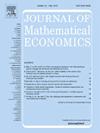Potentials in quadratic Cournot cross-holding games
IF 0.7
4区 经济学
Q3 ECONOMICS
引用次数: 0
Abstract
Do firms in an oligopoly market behave “as if” they were maximizing a common fictitious objective function, as in perfect competition and monopoly? The answer is yes under certain mild technical conditions (Slade, 1994). That is, in terms of Monderer and Shapley (1996), the Cournot competition is a potential game. In this paper, we ask the same question for Cournot competition with quadratic payoff functions and cross-holdings, an important variant of the oligopoly market. We find that, for various potential functions, the question can be more easily understood from the structure of the influence network, which is constructed from the cross-holding network. Roughly, we find that the Cournot competition with cross-holdings is a potential game if and only if the influence network is symmetric in certain generalized sense. Extending the model to Cournot competition with both overlapping ownership and product differentiation, we find that the previous results still hold. We also provide two applications of our results.
二次古诺交叉持棋的势
寡头垄断市场中的企业是否表现得“好像”它们在最大化一个共同的虚构目标函数,就像在完全竞争和垄断中一样?在某些温和的技术条件下,答案是肯定的(斯莱德,1994)。也就是说,就Monderer和Shapley(1996)而言,古诺竞争是一场潜在的比赛。在本文中,我们对具有二次支付函数和交叉持股的古诺竞争提出了同样的问题,这是寡头垄断市场的一个重要变体。我们发现,对于各种势函数,从影响网络的结构中可以更容易地理解问题,影响网络是由交叉持有网络构建的。粗略地说,我们发现交叉持股的古诺竞争是一个潜在的博弈,当且仅当影响网络在一定广义上是对称的。将模型扩展到既有所有权重叠又有产品差异化的古诺竞争中,我们发现之前的结果仍然成立。我们还提供了我们的结果的两种应用。
本文章由计算机程序翻译,如有差异,请以英文原文为准。
求助全文
约1分钟内获得全文
求助全文
来源期刊

Journal of Mathematical Economics
管理科学-数学跨学科应用
CiteScore
1.70
自引率
7.70%
发文量
73
审稿时长
12.5 weeks
期刊介绍:
The primary objective of the Journal is to provide a forum for work in economic theory which expresses economic ideas using formal mathematical reasoning. For work to add to this primary objective, it is not sufficient that the mathematical reasoning be new and correct. The work must have real economic content. The economic ideas must be interesting and important. These ideas may pertain to any field of economics or any school of economic thought.
 求助内容:
求助内容: 应助结果提醒方式:
应助结果提醒方式:


